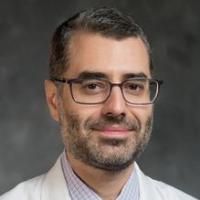Key Pathogenic Factors in Coronavirus Disease 2019-Associated Coagulopathy and Acute Lung Injury Highlighted in a Patient With Copresentation of Acute Myelocytic Leukemia: A Case Report.
Date
2021-03-30
Journal Title
Journal ISSN
Volume Title
Repository Usage Stats
views
downloads
Citation Stats
Attention Stats
Abstract
The role of concurrent illness in coronavirus disease 2019 (COVID-19) is unknown. Patients with leukemia may display altered thromboinflammatory responses. We report a 53-year-old man presenting with acute leukemia and COVID-19 who developed thrombotic complications and acute respiratory distress syndrome. Multiple analyses, including rotational thromboelastometry and flow cytometry on blood and bronchoalveolar lavage, are reported to characterize coagulation and immune profiles. The patient developed chemotherapy-induced neutropenia that may have protected his lungs from granulocyte-driven hyperinflammatory acute lung injury. However, neutropenia also alters viral clearing, potentially enabling ongoing viral propagation. This case depicts a precarious equilibrium between leukemia and COVID-19.
Type
Department
Description
Provenance
Subjects
Citation
Permalink
Published Version (Please cite this version)
Publication Info
Olson, Lyra B, Ibtehaj A Naqvi, Daniel J Turner, Sarah A Morrison, Bryan D Kraft, Lingye Chen, Bruce A Sullenger, Smita K Nair, et al. (2021). Key Pathogenic Factors in Coronavirus Disease 2019-Associated Coagulopathy and Acute Lung Injury Highlighted in a Patient With Copresentation of Acute Myelocytic Leukemia: A Case Report. A&A practice, 15(4). p. e01432. 10.1213/xaa.0000000000001432 Retrieved from https://hdl.handle.net/10161/22473.
This is constructed from limited available data and may be imprecise. To cite this article, please review & use the official citation provided by the journal.
Collections
Scholars@Duke

Bryan David Kraft
Dr. Kraft has a wide variety of clinical and research interests, including sepsis, pneumonia, and acute respiratory distress syndrome (ARDS), and has special expertise in rare lung diseases such as pulmonary fibrosis and pulmonary alveolar proteinosis (PAP). PAP can be congenital, hereditary, autoimmune, or due to occupational exposures (e.g. dusts, fibers, silica).
Dr. Kraft performs whole lung lavage (WLL) at Duke in a state-of-the art hyperbaric chamber within the Duke Center for Hyperbaric Medicine and Environmental Physiology. Performing WLL with hyperbaric oxygen (when necessary) augments oxygen delivery during the procedure, meaning both lungs can be lavaged on the same day, during a single episode of anesthesia.
Dr. Kraft’s research laboratory is devoted to understanding mechanisms of acute lung injury resolution, and uses translational models and clinical patient samples to identify novel pathways of recovery. Dr. Kraft is also an active investigator in clinical trials to develop new therapies for patients with lung diseases.

Bruce Alan Sullenger
The main focus of my translational research laboratory is to develop RNA based therapeutic agents for the potential treatment of a range of diseases. To this end, we have and will continue to take advantage of the fact that RNA is not just a passive carrier of genetic instructions inside of cells during the conversion of information from DNA to RNA to protein. Rather, RNA is an extremely versatile biological macromolecule. Certian RNAs can bind to specific protiens with high affinities, while others can for catalytic centers and perform enzymatic reactions. These facets of RNA coupled with the ease with which RNA can be manipulated in vitro make it a very powerful and unique therapeutic agent whose potential is largely untapped. Durring our endeavors, we plan to work closely with the members of the Molecular Therapeutics program as well as other faculty at the Duke University Medical Center to expedite the development and testing of these therapeutics.
The specific aims of my laboratory are:
1. To isolate and characterize RNA and DNA aptamers which block therapeutically relavent proteins such as those involved in cardiovascular diseases and immune modulation.
2. To develop RNA-based tumor targeting strategies for delivering siRNAs and miRNAs to tumor cells.
3. To reprogram cells using mRNA delivery.
4. To explore novel methods to control inflammation.

Smita K Nair
I have 22 years of experience in the field of cancer vaccines and immunotherapy and I am an accomplished T cell immunologist. Laboratory website:
https://surgery.duke.edu/immunology-inflammation-immunotherapy-laboratory
Current projects in the Nair Laboratory:
1] Dendritic cell vaccines using tumor-antigen encoding RNA (mRNA, total tumor RNA, amplified tumor mRNA)
2] Local immune receptor modulation using mRNA that encodes for antibodies, receptor-ligands, cytokines, chemokines and toll-like receptors (current target list: CTLA4, GITR, PD1, TIM3, LAG3, OX40 and 41BB)
3] Combination therapies for cancer: cytotoxic therapy (radiation, chemo and oncolytic poliovirus therapy) with dendritic cell-based vaccines and immune checkpoint blockade
4] Adoptive T cell therapy using tumor RNA-transfected dendritic cells to expand tumor-specific T cells ex vivo
5] Adoptive T cell therapy using PSMA CAR (chimeric antigen receptor) RNA-transfected T cells
6] Direct injection of tumor antigen encoding RNA (targeting antigens to dendric cells in vivo using nanoparticles and aptamers)

Loretta Georgina Que
My research interests focus on studying the role of nitric oxide and related enzymes in the pathogenesis of lung disease, specifically that caused by nitrosative/oxidative stress. Proposed studies are performed in cell culture and applied to animal models of disease, then examined in human disease where relevant. It is our hope that by better understanding the role of NO and reactive nitrogen species in mediating inflammation, and regulating cell signaling, that we will not only help to unravel the basic mechanisms of NO related lung disease, but also provide a rationale for targeted therapeutic use of NO.
Key words: nitrosative defense, lung injury, nitric oxide
Unless otherwise indicated, scholarly articles published by Duke faculty members are made available here with a CC-BY-NC (Creative Commons Attribution Non-Commercial) license, as enabled by the Duke Open Access Policy. If you wish to use the materials in ways not already permitted under CC-BY-NC, please consult the copyright owner. Other materials are made available here through the author’s grant of a non-exclusive license to make their work openly accessible.
